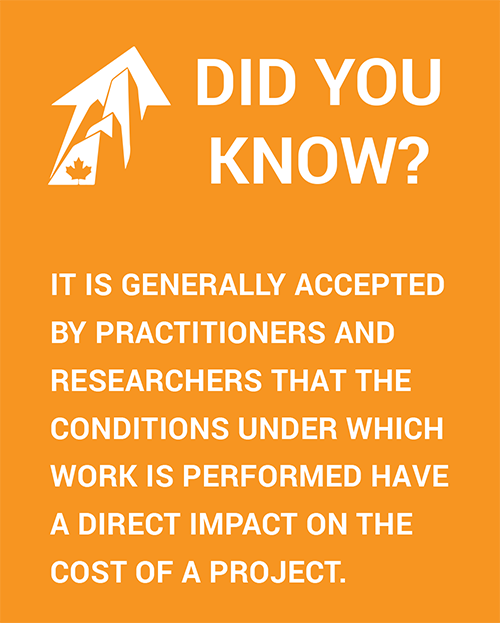

Cost practice:
Actual project costs are captured with supporting information, so that they can be re-used to develop future estimates.
Our largest unknown in the construction cost equation is the value of productivity. Influences on productivity are many and include the environmental conditions under which work is performed (e.g., temperature and humidity), and access to the space where the work is being performed (e.g., presence of other trades, available laydown areas). When estimates of the cost of construction are developed, assumptions are made to account for expected conditions that will be encountered during construction. Some take the approach of explicitly listing the expectations and their impact on an activity basis (e.g., exterior masonry block walls will cost 35% more during winter months), others might use an overall contingency to reflect project level expectations. With any approach, it is based on our knowledge of previous work and conditions.
During construction, there is no lack of motivation to quantify the costs that are incurred as work progresses. However, there are often many missed opportunities to capture the knowledge of the conditions under which the work was performed and what kind of impact this had on costs. Having this type of information can greatly improve the ability to more accurately predict the cost of future work. The information often finds its way into a variety of information sources (e.g., daily project reports, inspection reports) that are not always reconciled directly with our costs.
The Association for the Advancement of Cost Engineering has recommended practices surrounding cost accounting during construction (to identify, capture and classify), and risk assessment and setting contingencies (to reapply the captured knowledge) that assist in making the “link.” For example, an often-overlooked opportunity to capture condition information is through timesheets, arguably the most consistently completed document during construction and one that we can relate directly to actual cost.
Reference:
Next installment: Rework is good, but only if it helps us measure and improve our quality

ABOUT THE PERFORMANCE BENCHMARKING TOOL
The free Performance Benchmarking Self-Assessment Tool is designed to assist construction and maintenance employers in measuring their organization in relation to a specific set of recognized best practices. In addition, you will be able to compare your organization’s efforts against other construction and maintenance employers. From the results of the self-assessment tool you will also be able to identify areas for continuous improvement.
The self-assessment tool is designed to be completed either individually by a member of your management team or in a collaborative setting. Consider bringing your leaders/managers together to work through the tool and take time to discuss the perspectives of each group member.
This initiative is supported by the National Research Council of Canada Industrial Research Assistance Program (NRC IRAP).

Productivity
